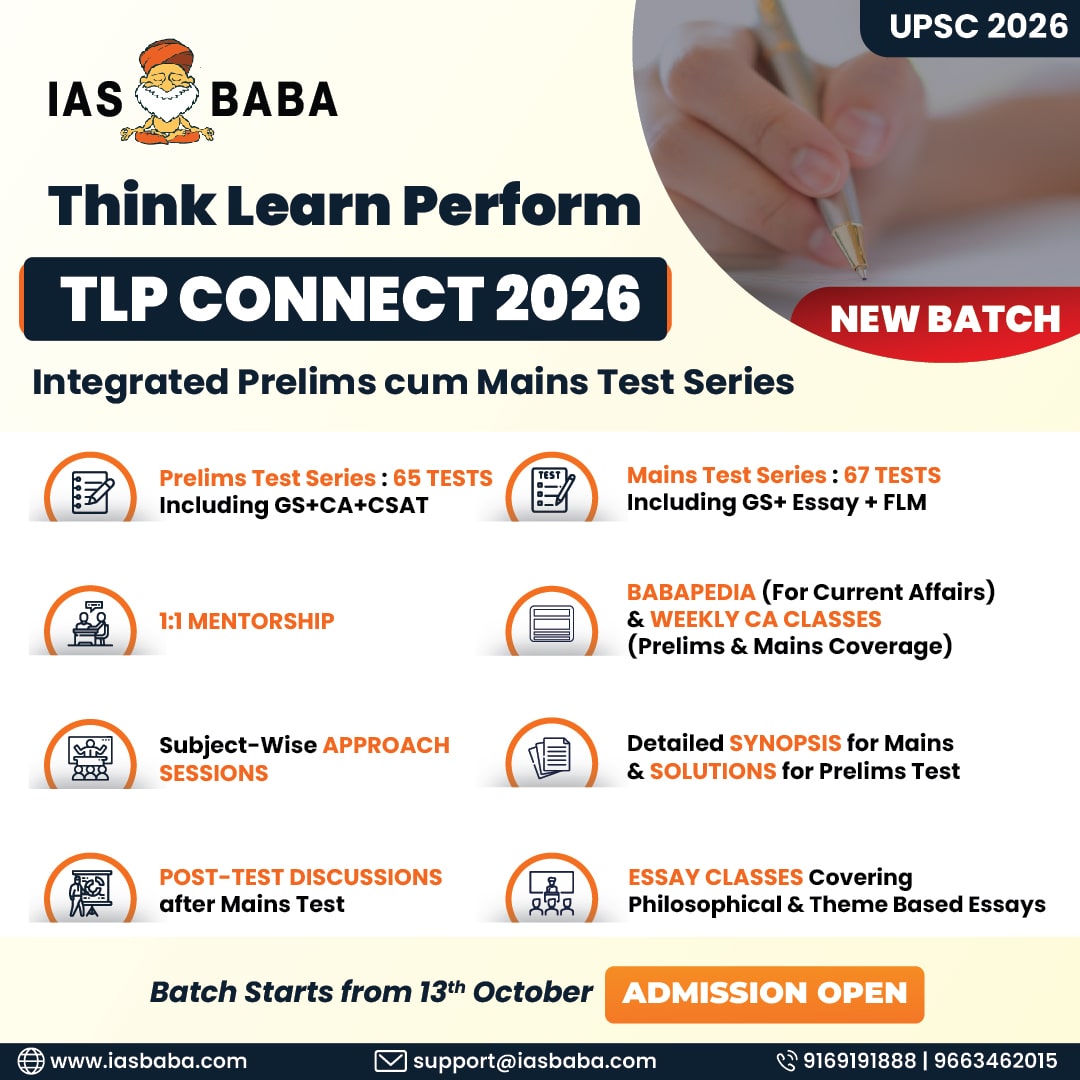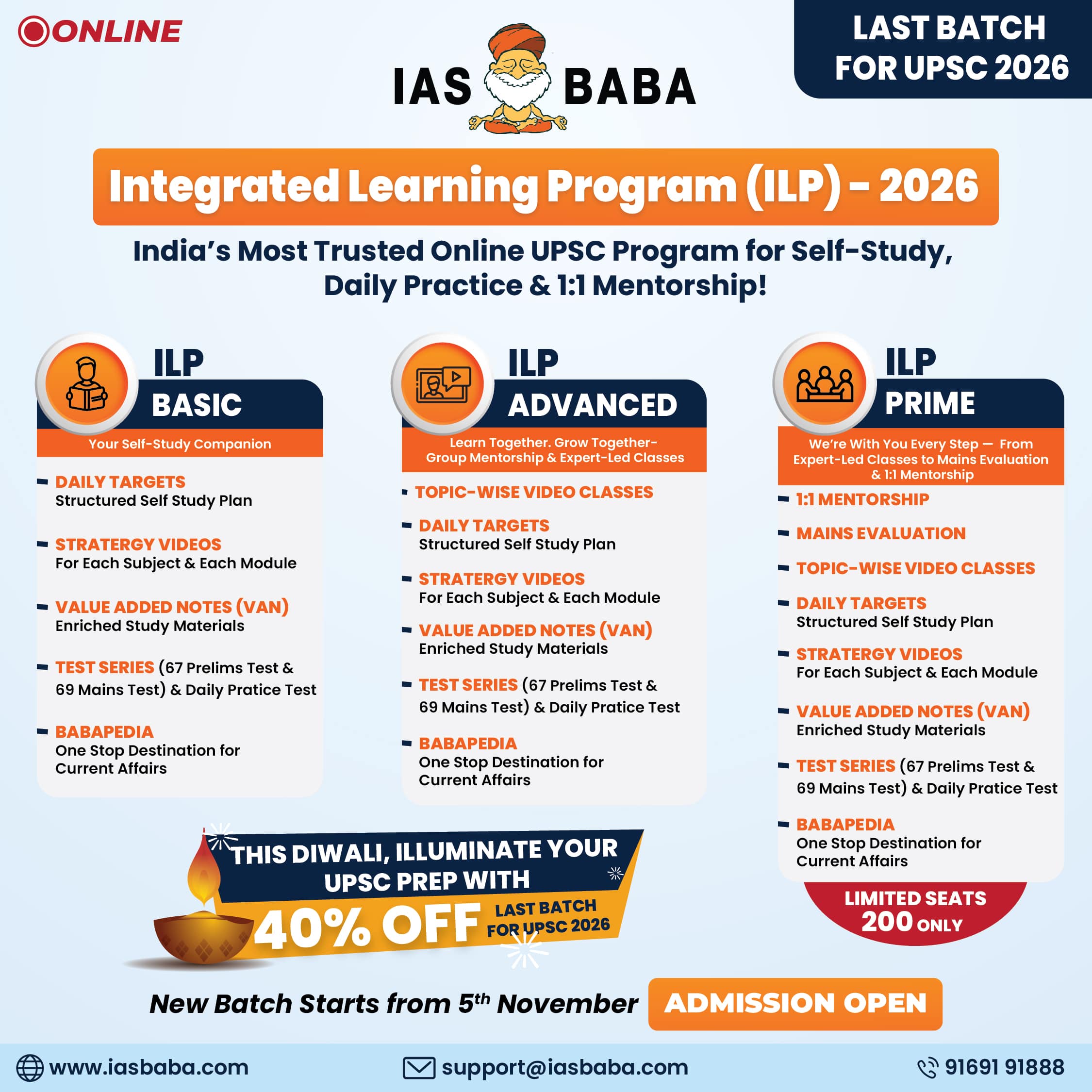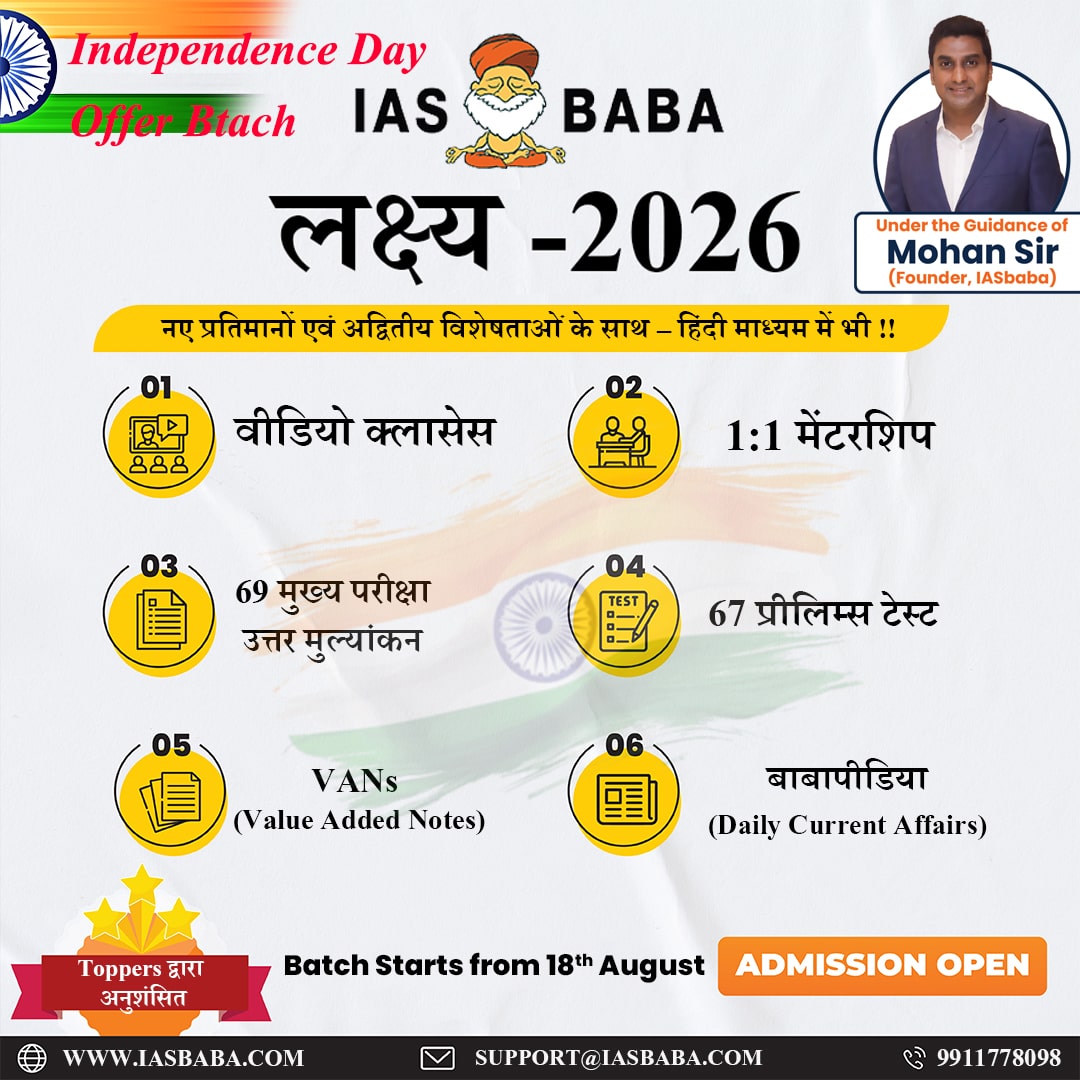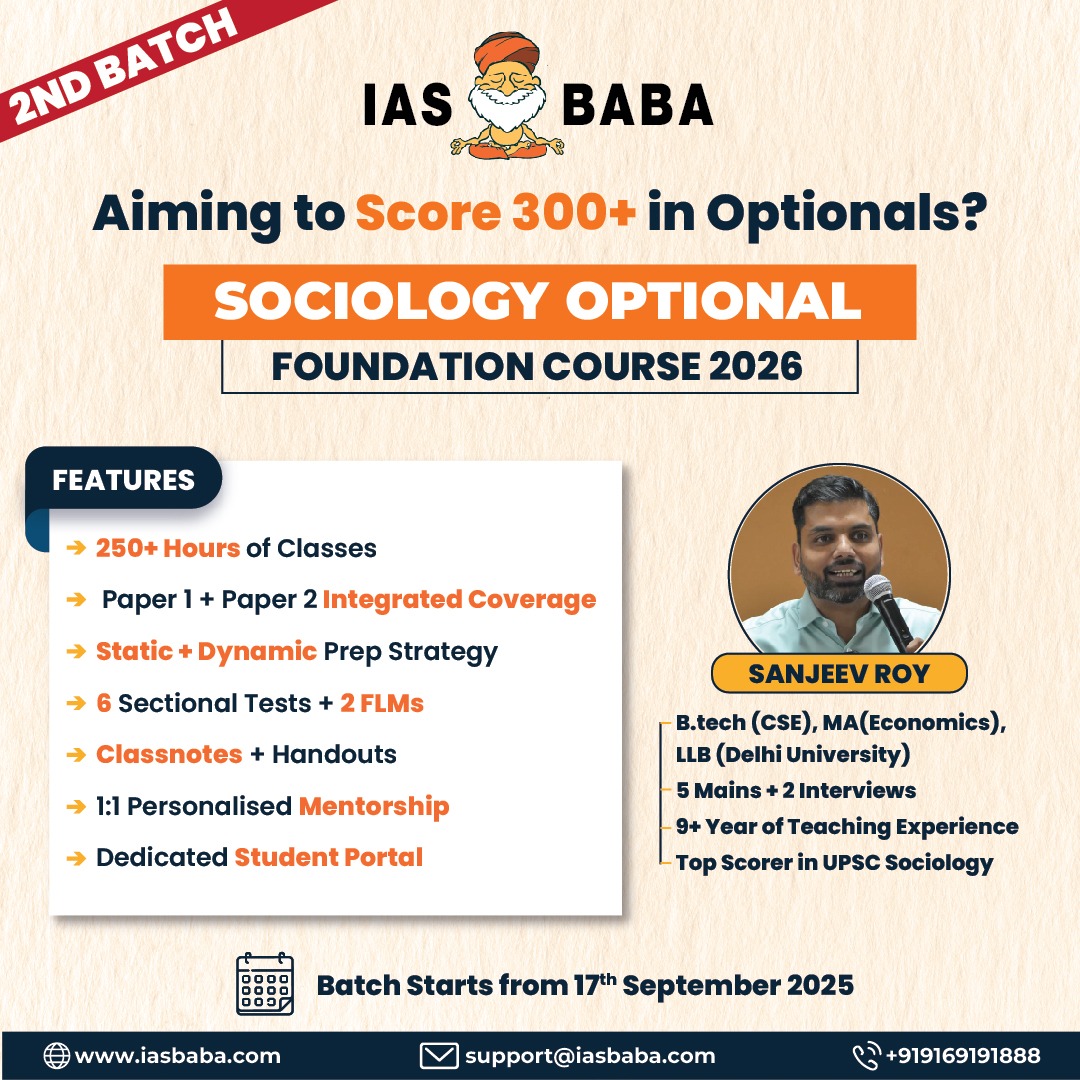IASbaba's Daily Current Affairs Analysis
Archives
(PRELIMS Focus)
Category: ECONOMICS
Context: India Post Payments Bank (IPPB) has been awarded the Digital Payments Award 2024–25 by the Department of Financial Services, Ministry of Finance
Decoding Context:
It has significant role in expanding digital payments and promoting financial inclusion across India.
The award was presented in New Delhi by Union Finance Minister Nirmala Sitharaman and Minister of State for Finance Pankaj Chaudhary. IPPB ranked first among all payments banks in the Performance Index for FY 2024–25, highlighting its strong digital banking performance and citizen-centric approach.
By utilizing its vast network of over 2 lakh Postmen and Gramin Dak Sevaks, IPPB has extended digital financial services to remote and rural areas, supporting the government’s vision of a cash-light, digitally empowered economy.
Learning Corner:
India Post Payments Bank (IPPB) – Brief Note
Launched: January 30, 2017
Owner: 100% Government of India (under the Department of Posts, Ministry of Communications)
Headquarters: New Delhi
Key Features:
- Established to leverage the postal network for providing banking services.
- Uses over 1.5 lakh post offices and 2 lakh postal staff (Postmen & Gramin Dak Sevaks) for last-mile delivery.
- Offers digital banking services such as savings accounts, money transfers, bill payments, and DBT (Direct Benefit Transfers).
- Focuses on financial inclusion by reaching unbanked and underbanked populations in rural and remote areas.
Payment Banks in India – Overview
Concept Introduced by: Reserve Bank of India (RBI) based on Nachiket Mor Committee recommendations in 2014
Launched: First licenses issued in 2015
Purpose:
- Enhance financial inclusion by providing small savings accounts and payments/remittance services to the underserved.
Key Features:
- Can accept deposits up to ₹2 lakh per customer (limit may be revised by RBI).
- Cannot issue credit cards or give loans.
- Can offer services like:
- Savings/current accounts
- Mobile and online banking
- UPI, IMPS, NEFT, AEPS-based transactions
- Utility bill payments and insurance (through third parties)
Examples of Payment Banks:
- India Post Payments Bank (IPPB)
- Airtel Payments Bank
- Paytm Payments Bank
- Fino Payments Bank
- NSDL Payments Bank
Significance:
- Help bridge the urban-rural banking divide.
- Promote cashless economy and digital financial literacy.
- Act as a low-cost, technology-driven solution for basic banking services.
Source: PIB
Category: ECONOMICS
Context: India’s core sector growth slowed to a nine-month low of 0.7% in May 2025
The decline was driven by contractions in electricity (-5.8%), fertilisers (-5.9%), natural gas (-3.6%), and crude oil (-1.8%).
While steel (6.7%) and cement (9.2%) recorded strong growth, and coal and refinery products also saw gains, these were not enough to offset the overall weakness. Economists attribute the slowdown to excessive rainfall and early monsoon onset, which affected power generation and mining.
Learning Corner:
Core Sectors of the Indian Economy – Brief Note
The Core Sectors are the key industries that have a major impact on the overall economic activity and industrial performance in India. These sectors are considered the foundation of industrial growth.
Eight Core Sectors:
- Coal
- Crude Oil
- Natural Gas
- Refinery Products
- Fertilisers
- Steel
- Cement
- Electricity
Key Points:
- These sectors collectively account for ~40.27% of the Index of Industrial Production (IIP).
- The performance of these sectors is released monthly by the Ministry of Commerce and Industry.
- Their growth is a leading indicator for measuring industrial performance and economic momentum.
- The Combined Index of Eight Core Industries (ICI) is used to track their performance.
Importance:
- Core sectors supply essential inputs for other industries and influence infrastructure development, manufacturing, and economic stability.
- Any fluctuations in these sectors significantly affect the GDP, inflation, and employment levels.
Index of Industrial Production (IIP) – Brief Note
The Index of Industrial Production (IIP) is a key economic indicator that measures the growth rate of various sectors of the economy, such as manufacturing, mining, and electricity, over a given period.
Released by:
National Statistical Office (NSO), Ministry of Statistics and Programme Implementation (MoSPI)
Base Year:
Currently 2011–12
Components of IIP:
- Mining
- Manufacturing
- Electricity
Use-Based Classification:
- Primary Goods
- Capital Goods
- Intermediate Goods
- Infrastructure/Construction Goods
- Consumer Durables
- Consumer Non-Durables
Importance of IIP:
- Measures short-term changes in the volume of production.
- Acts as a barometer of industrial activity.
- Helps in economic planning, policy formulation, and investment decisions.
- Reflects the health of the industrial sector, which contributes significantly to GDP.
Relation to Core Sectors:
- The Eight Core Sectors constitute around 40.27% of the weight in the IIP.
- Thus, performance in core industries has a direct impact on IIP trends.
Source: THE HINDU
Category: INTERNATIONAL
Context : British lawmakers have approved a landmark bill legalizing assisted dying for terminally ill adults in England and Wales.
UK Assisted Dying Bill – Key Highlights
Key Provisions:
- Applies to mentally competent adults (18+) diagnosed with a terminal illness and a life expectancy of less than six months.
- Requires approval from two doctors and a specialist panel (including a psychiatrist, social worker, and legal expert).
- Patients must self-administer the life-ending medication.
- Includes safeguards such as independent advocates for the disabled and a disability advisory board.
- Voluntary participation for medical professionals.
Public and Political Response:
- The issue remains deeply divisive, balancing compassionate choice versus concerns over vulnerability and abuse.
- The Labour government has taken a neutral stance, allowing MPs to vote based on personal conscience.
Once enacted, the UK would join countries like Canada, New Zealand, Spain, and several U.S. states in allowing assisted dying for terminally ill patients.
Learning Corner:
Assisted Dying / Euthanasia in India – Brief Note
In India, the issue of assisted dying or euthanasia is legally, ethically, and socially sensitive. While active euthanasia remains illegal, passive euthanasia has been permitted under strict conditions.
Types of Euthanasia:
- Active Euthanasia:
- Direct action (like administering a lethal injection) to end life.
- Illegal in India.
- Passive Euthanasia:
- Withholding or withdrawing medical treatment (like life support) that prolongs life in terminally ill patients.
- Legalized in 2018 under certain guidelines.
Legal Framework:
Key Case: Common Cause v. Union of India (2018)
- Supreme Court verdict recognized the right to die with dignity as part of Article 21 (Right to Life).
- Legalized passive euthanasia with strict procedural safeguards.
- Recognized Advance Medical Directives or “Living Wills”:
- Terminally ill patients can state their wish to not be put on life support.
- Requires approval by medical boards and jurisdictional authorities.
Conditions for Passive Euthanasia:
- Patient must be in a permanently vegetative or terminally ill condition.
- Requires:
- Approval by two medical boards.
- Consent of family/relatives.
- District Magistrate’s involvement.
Current Status:
- Active euthanasia is still prohibited.
- Passive euthanasia is permitted but rarely used due to complex legal and procedural requirements.
- The debate continues, with calls for clearer legislation and safeguards balancing individual autonomy and ethical concerns.
Source : THE HINDU
Category: SCIENCE AND TECHNOLOGY
Context : Hindustan Aeronautics Limited (HAL) has become the first Indian company to acquire complete technology to build and operate a launch vehicle, after winning ISRO’s bid for the Small Satellite Launch Vehicle (SSLV) program.
Decoding Context
Key Highlights:
- HAL won the bid with an offer of ₹511 crore, outbidding consortiums led by the Adani Group and Bharat Dynamics Ltd.
- Over the next two years, ISRO will assist HAL in developing two prototype SSLVs.
- After this phase, HAL will independently manufacture, market, and launch SSLVs for global commercial satellite missions.
- Target market: Launching satellites up to 500 kg into Low Earth Orbit (LEO).
- HAL aims to produce 6–12 SSLVs annually based on demand.
Significance:
- First-ever full rocket technology transfer in India’s space history.
- Unlike earlier collaborations where ISRO retained control, HAL will have complete ownership and operational autonomy.
- HAL becomes India’s third rocket manufacturer, after private firms Skyroot Aerospace and Agnikul Cosmos.
- A major step in privatizing India’s space sector and boosting the country’s share in the global launch market.
Strategic Impact:
- SSLV offers rapid deployment and low-cost launches, ideal for small satellite markets.
- Supports India’s vision of a $44 billion space economy by 2033.
- Aligns with global commercial space trends and strengthens public-private partnerships in aerospace.
Learning Corner:
Launch Vehicles of ISRO – Brief Note
The Indian Space Research Organisation (ISRO) has developed a series of launch vehicles (rockets) to place satellites into various orbits. These vehicles are crucial for India’s space missions, ranging from communication and remote sensing to interplanetary exploration.
- Satellite Launch Vehicle (SLV)
- First launch vehicle developed by India.
- Successful launch in 1980, placing Rohini satellite in orbit.
- 4-stage solid propellant rocket.
- Now retired.
- Augmented Satellite Launch Vehicle (ASLV)
- Developed to enhance payload capacity after SLV.
- Used between 1987–1994.
- Failed in early attempts, later succeeded.
- Now discontinued.
- Polar Satellite Launch Vehicle (PSLV)
- ISRO’s workhorse with a high success rate.
- First successful launch in 1994.
- Used to launch satellites into Sun-synchronous Polar Orbits.
- Capable of multi-satellite missions and launching into different orbits.
- Carried out missions like Chandrayaan-1, Mars Orbiter Mission (Mangalyaan).
- Geosynchronous Satellite Launch Vehicle (GSLV)
- Designed to launch communication satellites into Geosynchronous Transfer Orbit (GTO).
- Uses cryogenic upper stage.
- First successful mission in 2004.
- GSLV Mk II is operational.
- GSLV Mk III (LVM3)
- ISRO’s most powerful launcher to date.
- Used for Chandrayaan-2, and Gaganyaan (upcoming human spaceflight mission).
- Can carry heavier payloads (up to 4 tons to GTO).
- Used for launching commercial satellites and OneWeb satellites.
- Small Satellite Launch Vehicle (SSLV)
- Newest and cost-effective rocket for launching small satellites (up to 500 kg).
- Quick turnaround, suitable for commercial launches.
- Technology recently transferred to HAL for independent operation.
In Development / Future Launchers:
- Reusable Launch Vehicle (RLV): Prototype tested; aims to reduce cost of space access.
- Next-Gen Launch Vehicle (NGLV): Planned to replace PSLV, GSLV series with a modular, semi-cryogenic design.
Source: THE INDIAN EXPRESS
Category: INTERNATIONAL
Context: Israel-Iran conflict and Iran’s Potential Withdrawal from the NPT
Immediate Impacts on Iran:
- Unrestricted Nuclear Development: Iran could pursue nuclear weapons openly, beyond international treaty constraints.
- End of IAEA Oversight: Monitoring and inspections would stop, raising transparency concerns.
- Increased Risk of Conflict: Potential for pre-emptive military action, especially from Israel.
Regional Implications:
- Arms Race in the Middle East: Nations like Saudi Arabia, UAE, and Egypt may develop or accelerate nuclear programs.
- Destabilization of NPT Norms: Others may follow Iran’s example, undermining the treaty’s authority.
Global Consequences:
- Erosion of Nonproliferation Norms: Weakens global trust in nuclear agreements.
- Diplomatic Polarization: Divergent responses—U.S. and Europe may favor sanctions or force; Russia and China might resist punitive measures.
Strategic Risks for Iran:
- Economic Isolation: May face renewed UN sanctions and global backlash.
- Military Vulnerability: Loss of legal protections under NPT could legitimize external strikes.
Learning Corner:
Nuclear Non-Proliferation Treaty (NPT) – Brief Note
The Nuclear Non-Proliferation Treaty (NPT) is a landmark international agreement aimed at preventing the spread of nuclear weapons and promoting peaceful uses of nuclear energy.
Adopted:
1968
Came into Force:
1970
Members:
191 countries (nearly every UN member, except India, Pakistan, Israel, and North Korea which withdrew in 2003)
Three Pillars of the NPT:
- Non-Proliferation:
- Nuclear-weapon states agree not to transfer weapons or assist non-nuclear states in acquiring them.
- Non-nuclear states agree not to pursue nuclear weapons.
- Disarmament:
- All parties commit to pursue negotiations in good faith towards nuclear disarmament.
- Peaceful Use of Nuclear Energy:
- Promotes access to nuclear technology for peaceful purposes, under IAEA safeguards.
Nuclear Weapon States Recognized by NPT:
- United States
- Russia
- United Kingdom
- France
- China
(States that tested nuclear weapons before 1967)
Importance of NPT:
- Cornerstone of the global non-proliferation regime.
- Facilitates IAEA inspections and verification.
- Balances the rights of states to nuclear energy with obligations to prevent weaponization.
Source: THE INDIAN EXPRESS
(MAINS Focus)
Introduction (Context)
- Conflicts in 2025 – including Israel-Iran hostilities, India-Pakistan drone strikes, and Ukraine-Russia AI drone warfare – reveal the emergence of a new warfare model driven by Missiles, Artificial Intelligence (AI), and Drones (MAID).
- The MAID era marks a fundamental transformation in military strategy, accessibility of high-impact tools, and international security architecture.
What is MAID Warfare?
- M – Missiles: Long-range precision weapons capable of striking strategic targets.
- A – Artificial Intelligence (AI): Software algorithms enabling automated decision-making in combat.
- I – Intelligence (Machine-Based): Enhances surveillance, target acquisition, and battle planning.
- D – Drones: Unmanned Aerial Vehicles (UAVs) used for reconnaissance and attack missions.
Key Features of MAID Warfare
1. Low-Cost, High-Impact Combat
- Traditional systems (e.g., fighter jets like F-35) cost over $100 million.
- Drones cost under $50,000 and can be operated remotely.
- Reduces entry barriers for countries and non-state actors to engage in advanced warfare.
2. Remote Operations
- Operators can launch strikes from hundreds or thousands of kilometers away.
- Reduces risk to military personnel, encourages frequent usage of force.
3. High Precision and Rapid Strike Ability
- AI and machine learning enable real-time identification and targeting.
- Example: India’s precision strikes on Pakistani terror camps avoided civilian casualties.
4. Speed of Decision-Making
- Algorithms can act faster than human response time.
- Wars could escalate within minutes, bypassing human deliberation or diplomacy.
5. Psychological Detachment
- Distant, screen-based operations lower the emotional barrier for use of lethal force.
- Converts military aggression into political spectacle for public consumption.
Ethical, Legal, and Strategic Concerns of MAID Warfare
- Lack of Legal Frameworks
-
- International Humanitarian Law (IHL), including the Geneva Conventions, was created for conventional warfare involving human soldiers and identifiable weapons.
- These laws do not address AI-based, autonomous, or unmanned systems, which are central to MAID warfare.
- The absence of regulation makes it difficult to ensure compliance with basic humanitarian principles like distinction and proportionality.
- Erosion of Deterrence Logic
-
- Traditional military deterrence is based on high economic, political, and human costs of war (e.g., nuclear weapons).
- MAID technologies are low-cost and remotely operated. Allow nations to use force without risking soldier lives or facing domestic backlash.
- Crisis stability is weakened, as states may engage in preemptive or symbolic strikes.
- Breakdown of International Institutions
-
- United Nations (UN) and its organs (like the UN Security Council) are struggling to regulate or respond to new forms of warfare.
- Powerful nations bypass UN authority, acting unilaterally using drones and AI-based strikes.
- No binding international agreement on use of lethal autonomous weapons systems (LAWS).
- Accountability Crisis
-
- When a war crime is committed by a machine or algorithm, traditional accountability frameworks fall apart.
- Autonomous warfare blurs the chain of command, making it difficult to uphold justice or pursue war crime investigations.
Risks Ahead
- Escalation without Control: Wars could start or spiral before diplomacy even reacts.
- Technology Outpacing Governance: No equivalent development in legal or diplomatic safeguards.
- Non-State Actor Empowerment: Terrorist groups and rebels can now acquire battlefield-grade capabilities.
Value addition: Terminologies
-
- Geneva Conventions: A set of international treaties that establish the standards of humanitarian treatment during war, focusing on the protection of civilians, wounded soldiers, and prisoners of war. First adopted in 1864 and expanded in later years.
-
- Lethal Autonomous Weapons Systems (LAWS): Weapons systems that can select and engage targets without direct human intervention, using artificial intelligence to operate independently on the battlefield. They raise legal, ethical, and accountability concerns in modern warfare.
Conclusion
MAID is not a future threat it is a present danger. International community must develop new global treaties and laws for autonomous and AI warfare. Establish ethical frameworks for usage of drones and precision strikes. Reinforce multilateral institutions like the UN to manage emerging security risks. Otherwise, the precision and remoteness of MAID warfare may make conflicts more frequent, cheaper to start, and harder to stop.
Mains Practice Question
Q “Evaluate the challenges posed by emerging military technologies like AI and drones for global peace and security.” (250 words, 15 marks)
Introduction (Context)
The Election Commission of India (ECI) has issued a revised standard operating procedure (SOP) for the checking and verification of electronic voting machines (EVMs), which second- and third-placed candidates in an election can opt for, following directions from the Supreme Court (SC).
Supreme Court Judgment
- In a landmark judgment on April 26, 2023, the SC rejected a plea for 100% VVPAT slip counting but allowed second and third-placed candidates in an election to seek verification of EVMs.
- The first SOP (2024) allowed verification of burnt memory/microcontroller of up to 5% of EVMs through mock polls.
- Petitioners like the Association for Democratic Reforms (ADR) raised concerns, especially about the erasure of data and lack of scrutiny of Symbol Loading Units (SLUs).
- On May 7, 2025, the SC accepted ECI’s proposal to revise its SOP and preserve data.
What are EVM?
- Electronic Voting Machine (also known as EVM) is voting using electronic means to either aid or take care of the chores of casting and counting votes.
- An EVM is designed with two units: the control unit and the balloting unit. These units are joined together by a cable. The control unit of the EVM is kept with the presiding officer or the polling officer. The balloting unit is kept within the voting compartment for electors to cast their votes. This is done to ensure that the polling officer verifies your identity. With the EVM, instead of issuing a ballot paper, the polling officer will press the Ballot Button which enables the voter to cast their vote. A list of candidates names and/or symbols will be available on the machine with a blue button next to it. The voter can press the button next to the candidate’s name they wish to vote for.
- First introduced in 1982 (Kerala); used extensively in all Lok Sabha and State Assembly elections since 2004.
Benefits:
- Faster vote recording and counting compared to paper ballots.
- Minimizes invalid votes, human errors, and ballot manipulation
- Reduces paper usage; cost-effective over time.
- Standalone (non-networked) devices; no internet/Bluetooth connectivity, hence tamper proof
- Built-in self-check mechanisms to detect malfunction.
What are VVPAT?
- VVPAT stands for Voter Verified Paper Audit Trail. It’s a mechanism that allows voters to verify if their vote has been cast correctly.
- When a person vote using an Electronic Voting Machine (EVM), the VVPAT system generates a paper slip. This slip shows the symbol of the party the person voted for. The slip automatically drops into a sealed box, ensuring that it can’t be tampered with.
Benefits:
- The primary purpose of VVPAT is to make the voting process as transparent as possible. By allowing voters to verify their own votes, it builds trust in the electoral system. Voters can leave the polling booth with confidence that their vote has been correctly recorded and counted.
- Errors and malfunctions can occur in any system, including EVMs. VVPAT provides a way to cross-check the electronic tally with the paper slips, ensuring that the final count is accurate. If there’s a discrepancy between the EVM count and the paper slip count, the paper slips can be used for a recount.
- Knowing that every vote is backed up by a paper slip that can be manually counted makes it much harder for anyone looking to tamper with the election results. The existence of VVPAT acts as a strong deterrent to fraud and manipulation.
What is the New SOP?
- Data Preservation:
- ECI will not delete data from EVMs or Symbol Loading Units that are under verification.
- SLU data used to upload symbols on VVPATs will also be retained.
- Revised Charges:
- Candidates can opt for: Self-diagnostic test only: ₹23,600 per EVM set and Self-test + mock poll: ₹47,200 per set.
- Candidate Participation:
- Candidates may choose to use either: The already-loaded symbols on VVPAT, or Reload the original symbols from Symbol Loading Unitsfor the mock poll.
- Mock Poll Procedure:
- BEL/ECIL engineers will activate Ballot Unit, Control Unit, and VVPAT in candidate presence.
- No errors in self-diagnostic test → proceed with mock poll (up to 1400 votes).
- Retention of Records:
- All related records (VVPAT slips, video footage, etc.) to be stored for 3 months (earlier: 1 month).
Significance of the SOP
- Strengthens electoral transparency and accountability.
- Empowers losing candidates with technical verification rights.
- Addresses concerns over tampering at symbol loading stage (SLU).
- Reflects judicial-ECI collaboration in upholding voter confidence.
Criticism
According to ADR:
- The process merely replicates routine pre-election tests.
- It lacks the spirit of thorough independent verification.
- Switching on machines and mock polls don’t guarantee tamper-proof assurance.
Terminologies
- Symbol Loading Unit (SLU): A device used to upload the symbols of contesting candidates onto the VVPAT machines before polling.
- Ballot Unit (BU): The part of the EVM where the voter presses the button to cast their vote for the desired candidate.
- Control Unit (CU): The component of the EVM operated by polling officials to enable voting and store vote data securely.
- Self-Diagnostic Test: An automatic check run by EVMs during setup to detect internal errors or malfunction before polling begins.
- Association for Democratic Reforms (ADR): A non-profit electoral watchdog in India known for advocating transparency, accountability, and electoral reforms.
- Burnt Memory / Microcontroller: The non-rewritable memory in an EVM where final vote data is stored; crucial for verifying that vote counts were not tampered with post-poll.
Mains Practice Question
Q “Discuss the role of the Election Commission in ensuring electoral transparency through the verification of EVMs and VVPATs in the context of recent judicial directions.” (250 words, 15 marks)
Daily Practice MCQs
Today’s – Daily Practice MCQs’ will be updated in our “Daily Current Affairs Quiz” section on our website
Please click on the below link












